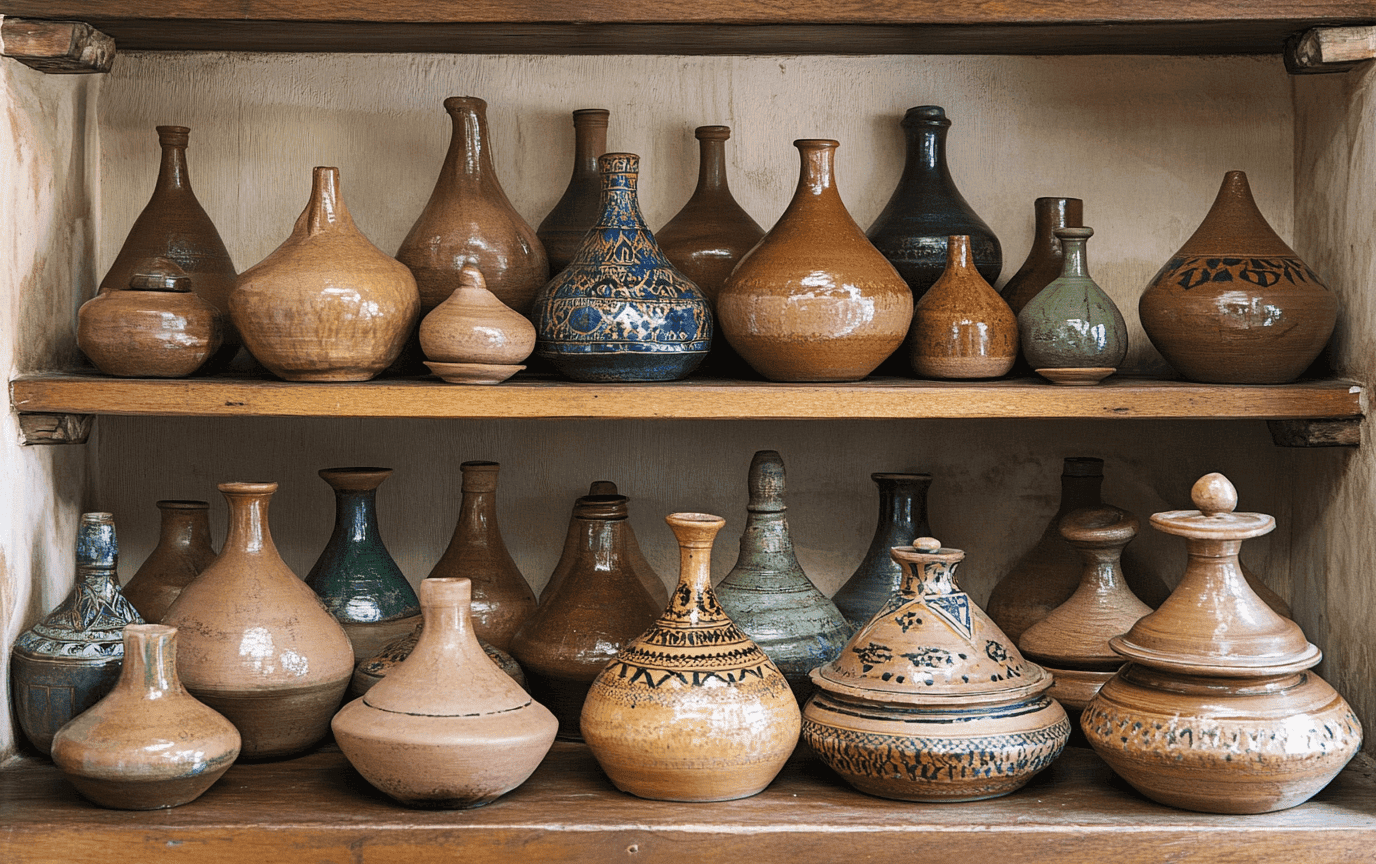A Guide to Moroccan Cuisine: Tagines and Beyond
Moroccan cuisine is a symphony of flavors that sings to the heart of its people—a blend of Arab, Berber, Andalusi, and Mediterranean traditions painting a culinary landscape rich in history and warmth. As you dive into the notes of spice and the threads of culture that weave through this gastronomic tapestry, you are invited to explore the iconic tagine, a beloved symbol of Moroccan cooking, alongside the myriad of other dishes that define this vibrant cuisine.
The Structure of Moroccan Meals
A traditional Moroccan meal is a celebration, a theatrical performance involving multiple acts that tease the senses and draw people together. Imagine a sun-washed table adorned with platters of color, where it all begins with a series of hot and cold salads, collectively known as “salades.” There, you meet every shade of the vegetable spectrum, beckoning your palate with tantalizing tastes.
As you shift towards the main event—a savory tagine or fluffy couscous—your taste buds dance in anticipation. Formal meals often showcase lamb or chicken, with couscous reigning as the cornerstone of many an occasion, crowned with the finest meats, vegetables, and a medley of spices, filling the air with aromatic whispers of cumin, cinnamon, and saffron.
In the embrace of Moroccan tradition, hands realize their divine purpose, tearing bread into pieces to scoop up delicious morsels. It’s more than eating; it’s a way of connecting—almost sacred. The typical Moroccan bread, khobz, made from durum wheat semolina, is a staple found in every household and bakery, offering sustenance and comfort alike while maintaining a respectful distance from pork and alcohol due to cultural customs.
The Iconic Tagine
What is a Tagine?
A tagine is not merely a dish; it is an experience rooted in history. This iconic cooking vessel—a round base with a cone-shaped lid—acts as a time capsule, preserving flavors and aromas. As steam rises and circulates, it transforms simple ingredients into a soulful experience, imbuing every bite with deep, rich flavors.
How to Use a Tagine
Using a tagine is like forging a bond with your ingredients, an intimate act that begins well before the flame is lit. If it’s your first time, nurture the clay by soaking it, drying it, and lovingly baking it with olive oil, preparing it for the culinary journey ahead. Here’s how to coax magic from this vessel:
- Base Layer: Begin with a fragrant layer of onions, garlic, or carrots, guarding against sticking.
- A Glug of Olive Oil: Pour in the liquid gold, creating a rich sauce that beckons.
- The Heart of the Dish: Place the chosen meat—be it the tender embrace of chicken, lamb, or the ocean’s bounty of fish—nestled amid an array of colorful vegetables.
- Essence of Spices: Like an artist wielding a brush, paint your creation with spices—generous pinches of cumin, coriander, cinnamon, and ginger—all mingling to create depth.
- Liquid Touch: Add just enough water or broth to keep the dish moist yet not soupy.
- Gentle Heat: Set the tagine on low to medium-low heat—patience is the chef’s best friend here. Allow the ingredients to marry and meld, transforming into a dish that’s tender and bursting with life.
Popular Tagine Recipes
Chicken Tagine
Among the vast repertoire of tagines, the chicken tagine stands out—a symphony of braised chicken elevated by the notes of garlic, onion, olives, and the bright zing of preserved lemons. Here’s how to take a step into this culinary embrace:
- Ingredients: Bone-in, skin-on chicken thighs, a drizzle of olive oil, cloves of garlic, onions, aromatic spices (cumin, coriander, ginger, cinnamon), chicken broth, a touch of honey, vibrant carrots, Mediterranean green olives, and fresh cilantro.
- Instructions: Start by browning the chicken to seal in its essence. As the golden skin crackles, add onions and garlic until they soften and release their fragrance. Next, introduce your spices and broth—let it all simmer into a flavorful embrace before serving atop a cloud of couscous.
Other Tagine Variations
- Lamb Tagine: This dish often revels in the sweetness of dried fruits like plums and cherries, coaxed out by a blend of spices.
- Fish Tagine: Coastal homes whip up fresh fish mingled with spices, a nod to their bounty from the sea.
- Vegetable Tagine: A vegetarian delight capturing the earth’s finest produce, vibrant and spiced to perfection.
Beyond Tagines: Other Moroccan Dishes
Couscous
Couscous, a beloved staple, holds a regal status in Moroccan households. A dish born from crushed durum wheat semolina, it is typically topped lavishly with tender beef or lamb, kissed by the warmth of gently steamed vegetables. Fridays echo with the anticipation of this quintessential offering, bringing families together in celebration.
Pastilla (Basteeya)
Pastilla is a metaphor for culinary luxury; this layered pie encapsulates the soul of Moroccan food. Imagine flaky pastry enveloping tender meat—chicken or fish—crowned with the zest of spices and the sweetness of cinnamon, each forkful echoing tales from the coast where it’s often prepared.
Tanjia
In the heart of Marrakech, Tanjia is a communal pot, a revelation simmering with meat, herbs, and spices. Imagine it nestled within the ash of smoldering coals, warmth wrapping around it like a comforting hug, each serving a testament to generations of camaraderie.
Soups
- Harira: A heartwarming concoction of chickpeas, tomatoes, and spices that beckons one home during Ramadan, as well as on chilly winter nights.
- Bissara: This broad bean soup emerges as a cozy embrace, savored during the colder months.
- Beboush: A culinary gem, this savory snail soup unfolds aromatic layers of cumin, coriander, and mint, casting a spell of warmth.
Salads
Moroccan salads paint a canvas of vibrant colors; they are both raw and cooked, bursting with flavors that stir the spirit. Prominent examples include:
- Zaalouk: Smoky and comforting, a salad of grilled eggplant bathed in tomato goodness.
- Taktouka: A beautiful blend of tomatoes and smoked green peppers resulting in a fresh sensation.
- Bakoula: Braised mallow leaves or spinach, mingled with parsley, cilantro, lemon, and olives, making each bite sing.
Desserts
In the realm of desserts, Moroccan sweetness is often uncomplicated yet satisfying, inviting you to savor seasonal fruits and simple pastries:
- Kaab el Ghzal: Delicate pastries cradling an almond filling, each bite dusted with sugar, echoing nostalgia.
- Halwa Chebakia: The pretzel-shaped delight, kissed by honey and sprinkled with sesame to celebrate Ramadan.
- Jowhara: Originating from Fes, this cream-filled pastry encased in golden fried dough dances on your palate with delight.
Bread and Bakeries
Bread holds a revered place at every Moroccan table; khobz is only the beginning. Picture the local bakeries—an everyday ritual where fresh bread emerges, warm and inviting. Variations abound—whole-grain dense loaves to airy baguettes, each inviting the hand to tear and dip, to unravel stories woven through time.
Seafood in Moroccan Cuisine
In coastal realms, the bounty of the sea permeates the dishes—cherished species like mackerel and anchovy transform into culinary masterpieces. Chermoula-marinated mackerel sings with the flavors of garlic and herbs, and fish pastilla wraps the ocean’s gift in layers of pastry and spices, crafting a dish where land and sea unite.
Ramadan and Traditional Meals
The sacred month of Ramadan brings forth unique rites of communal dining. The first meal, or ftour, emerges at sunset, starting with harira soup, sweet dates, and pastries—an embrace of nourishment after a day of fasting. Families gather, sharing bread and love in equal measure, weaving a tender connection that feels like the fabric of life itself.
Conclusion
Moroccan cuisine is not merely food; it is a celebration of life, a dance of flavors that beckons every traveler to indulge in its stories. Whether you find yourself enchanted by the aromatic tagine, the hearty warmth of couscous, or the delicate pastilla, there lies an exquisite tapestry of experiences to unfold. As you meander through the bustling souks of Marrakech or the salty sea breeze of Essaouira, let’s allow the flavors of Morocco to transport you—the spice, the soul, and the stories etched in every dish awaiting to be explored.
Want to stay updated on the latest travel tips? Check out our Travel Tips section. Looking for lifestyle inspiration? Explore our Lifestyle category. Discover amazing destinations.
For more visual delights, connect with us on YouTube, or follow our adventures on Instagram, and Pinterest.













